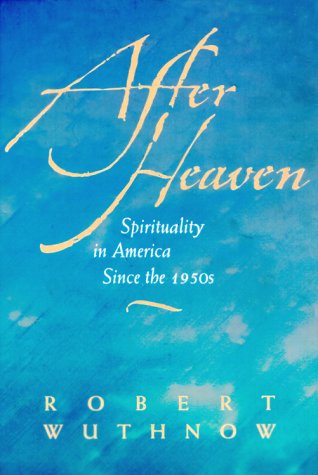In After HeavenRobert Wuthnow analyzes spiritual trends in America in the second half of the 20th century. Through interviews, opinion surveys, and research studies, his findings are a descriptive history of spirituality from the 1950’s to the year 2000, and a prescriptive solution in that Wuthnow posits a spirituality of “practice” as being more useful than a spirituality of “dwelling” or “seeking”.
The 50’s were an idyllic time of spirituality for Americans. Spirituality was largely “dwelling” based, that is, emphasis was placed on the home, with the father (representing God) as the familiar head of the family, and identities were fixed as part of the community. Uncertain and troubled times, fear of failure, tension with the Communists, the atom bomb, and memories of World War II were all reasons given for why people engaged in religious revival. For some, spirituality was a search for novel ways to retrieve a sense of sacred space. “The power of sacred places…is their capacity to marshal an individual’s inner resources and to strengthen that person’s convictions” (50). No place is inherently sacred; it is what one puts into it that makes it sacred—like how a house becomes a home.
The 60’s entailed freedom from fixed cultural norms. People were taught that spirituality depended on tight-knit bonds of ethnic and religious attachments, so as those attachments weakened, so did the traditional power of religion. Freedom of conscience, on the one hand, implies an absence of external intrusion into homogenous communities with authoritative standards of right and wrong. Sacred space allows for freedom as long as primary loyalty to the community is maintained. On the other hand, freedom of choice is valuable when individuals must make their way among multiple communities. (59) However, the freedom that emerged in the 1960’s proved to be unstable because it did not sufficiently take into account the social forces shaping it. “It made freedom largely into a matter of life-style, subjective opinion, and choice. The grand narrative of religious and philosophical tradition was replaced by personalized narratives of exploration and expression” (83). This prompted a spirituality of “seeking”.
If spiritual diversity blossomed in the 1960’s then fundamentalism flourished in the 1980’s. Discipline was sought because it brought reassurance, cheery dispositions, faith in goodness, and fulfillment of one’s desires. “To be in favor of a disciplined life was to avoid the moral chaos that one read about in the newspapers and to give up the wild-eyed restlessness of the 1960’s” (113). Wuthnow also notes that because religious organizations no longer hold a monopoly on authoritative interpretation of spiritual experiences (angels, near-death experience, etc.), popular culture began to fill the void with its own perspectives. People still experienced the sacred with reverence, even in a secular culture, but it began to be shaped by what they saw on television, what they learned in school, and what their families taught them.
Americans put more emphasis on the self, but it is not simply narcissism; “the collapse of a sacred canopy under which to live in spiritual security has awakened a compulsion for faith of a new kind, a faith that requires inner knowledge and that must be renewed and renegotiated with life experience” (167).
This leads to Wuthnow’s conclusion. If settled times are conducive to an imagery of dwellings (“dwelling” spirituality, fundamentalist, conservative, etc.), and unsettled times to an imagery of journeys (“seeking” spirituality, liberalism, freedom, etc.), and both have been found wanting in providing people with a sustainable spiritual framework, then the solution is a spirituality of practice. This is a spirituality where one develops regular habits of cultivating a relationship with the divine, or at least some kind of self-reflection (meditation, feeding the homeless, hospitality, etc.). Spiritual practices are inherently social in that they participate in some kind of tradition. “To practice is to accept the standards of evaluation that are a part of practice, such as the rules by which the winner of a chess match is decided…” (184). However, these rules need not be accepted blindly: practitioners are always challenging norms as well as conforming to them. One can in fact make up one’s own rules, but may pray the price for doing so. Practice spirituality makes a deliberate attempt to engage the sacred, and while it may be messy, it provides the vital element of sustained commitment and electrifies “the spiritual impulse that animates all of life” (198).
Wuthnow, R. (1998). After heaven: Spirituality in America since the 1950s. Berkeley: University of California Press.

